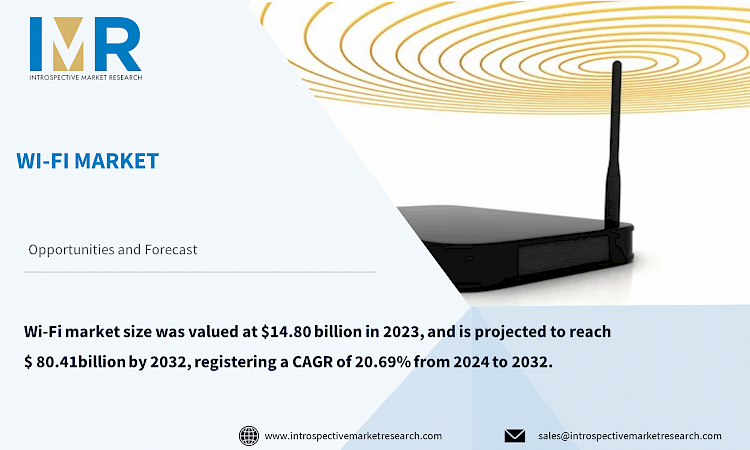
According to a new report published by Introspective Market Research, titled, “Wi-Fi Market by Component, Density, Location Type, Organization Size, and Applications: Global Opportunity Analysis and Industry Forecast, 2024–2032,”
global Wi-Fi market size was valued at $14.80 billion in 2023, and is projected to reach $ 80.41billion by 2032, registering a CAGR of 20.69% from 2024 to 2032.
Wi-Fi is a wireless networking technology that connects devices like smartphones, laptops, and tablets to the Internet or local networks without physical cables. It uses radio waves to transmit data between devices and a wireless router or access point. Operating on 2.4 GHz and 5 GHz frequencies, Wi-Fi networks offer faster speeds and less interference. It supports multiple encryption and security protocols to protect data transmission and ensure privacy. Devices authenticate with a password or security key, and once connected, they can access the internet, share files, and communicate with other devices. Recent advancements in Wi-Fi technology, such as Wi-Fi 6 (802.11ax) and Wi-Fi 6E, have enhanced network performance and capacity for bandwidth-intensive applications like 4K video streaming and IoT devices.
According to The Wi-Fi Market is segmented into Component, Density, Location Type, Organization Size, Applications, and region. By Component, the market is categorized into Hardware, Solutions, and Services. By Density, the market is categorized into Hi-Density and Enterprise-class. By Location Type, the market is, categorized into Indoor, Outdoor. By Organization Size, the market categorized into Large Enterprises and SMEs. By Applications, the market is categorized into Education, Healthcare and Life Sciences, Transportation and Logistics, Manufacturing, and Others By region, it is analyzed across North America (U.S.; Canada; Mexico), Eastern Europe (Bulgaria; The Czech Republic; Hungary; Poland; Romania; Rest of Eastern Europe), Western Europe (Germany; UK; France; Netherlands; Italy; Russia; Spain; Rest of Western Europe), Asia-Pacific (China; India; Japan; Southeast Asia, etc.), South America (Brazil; Argentina, etc.), Middle East & Africa (Saudi Arabia; South Africa, etc.).
The Internet of Things (IoT) has significantly impacted the Wi-Fi market due to its interconnected network of devices, vehicles, and buildings. Wi-Fi technology facilitates data exchange within the IoT ecosystem, and its robust wireless communication infrastructure is well-suited for connecting various IoT devices. As IoT devices become more prevalent in sectors like smart homes, industrial automation, healthcare, and smart cities, the demand for reliable and high-performance Wi-Fi connectivity has surged. Wi-Fi's widespread availability and integration into various environments make it easier for IoT device manufacturers to build connectivity solutions, reducing deployment costs and complexity. The evolution of Wi-Fi standards, such as Wi-Fi 6 (802.11ax) and Wi-Fi 6E, has further enhanced its capacity, speed, and support for IoT devices.
Government initiatives to create smart cities have created significant opportunities for the Wi-Fi market. These cities use advanced technologies to enhance residents' quality of life, infrastructure efficiency, and sustainability. Wi-Fi networks are crucial for providing widespread internet access, bridging the digital divide, and increasing digital inclusion. Governments invest in these networks to expand their reach. Wi-Fi is essential for applications like intelligent traffic management, public safety, environmental monitoring, and smart grid solutions. Government-backed projects often involve Wi-Fi access points and sensors, boosting demand for Wi-Fi technology and services.
Global Wi-Fi Market, Segmentation
The Wi-Fi market is segmented based on Component, Density, Location Type, Organization Size, Applications, and region.
Component:
The hardware segment is expected to dominate the market during the forecast period, consisting of physical components like CPUs, RAM, storage devices, motherboards, graphics cards, power supplies, and input/output devices. Hardware is the foundation for software operations, executing instructions, and processing data for applications and operating systems. It is found in personal computers, smartphones, tablets, servers, networking equipment, and other electronic devices. CPUs serve as the "brain" of a computer, while memory stores data for quick access, and storage devices retain data over longer periods.
Density:
High-density materials play a crucial role in various sectors due to their ability to pack functionality and strength into smaller spaces, making them highly sought-after. They are used in electronics, construction, and automotive to create powerful devices, sturdy structures, and enhanced vehicles. With a 25% share, these materials are widely adopted and valued by industries due to their ability to optimize space and resources without compromising quality or performance.
Region:
The Asia Pacific region is experiencing a surge in Wi-Fi demand due to internet adoption and smartphone dependence. Smart city initiatives, transportation, public safety, utilities, and education projects are driving market expansion. China, with a vast 5G network, plans to erect over 600,000 base stations in the region. Wi-Fi is also widely used for indoor applications in China, driven by its consumer electronics industry. In November 2020, ZTE unveiled its first Wi-Fi offering, the ZTE ZXV10 B860AV6, offering high-speed internet access, stability, low latency, and Wi-Fi 6 transmission quality of service (QoS) solutions.
Some of The Leading/Active Market Players Are-
- Cisco (US)
- Juniper Networks (US)
- Extreme Networks (US)
- NETGEAR (US)
- Aruba (US)
- Fortinet (US)
- Casa Systems (US)
- Broadcom (US)
- Ubiquiti Networks (US)
- AT&T (US), and Other Active Players
Key Industry Developments
- In September 2023, Huawei introduced the Huawei Router 3B Pro with WiFi-7 capabilities, which can transfer a single file through both 2.4gHz and 5gHz channels to boost speed.
- In August 2023, US Cellular and Ericsson collaborated to provide private wireless network solutions for various industry segments. This includes an initial focus on Industry 4.0 manufacturing, logistics, distribution, and warehouse use cases, expanding into hospitals, Industrial Internet of Things (IIoT), ports, utilities, and airports.
Key Findings of the Study
- The global Wi-Fi market was valued at $14.80 billion in 2023, with projections indicating sustained growth to reach $ 80.41 billion by 2032, showcasing a robust CAGR of 20.69% during the forecast period.
- The Wi-Fi market segmentation includes hardware, solutions, services, density categorization, indoor/outdoor locations, and organization sizes targeting large enterprises and SMEs.
- The Asia Pacific region is witnessing a surge in Wi-Fi demand driven by factors like internet adoption, smart city initiatives, and significant investments in infrastructure, with China emerging as a key player due to its extensive 5G network and consumer electronics industry.






